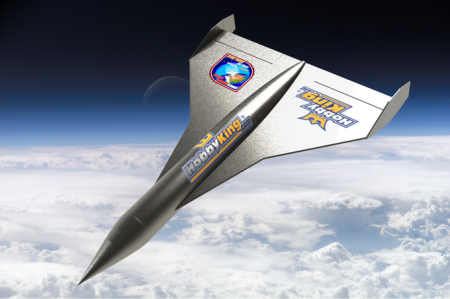May 28, 2015 – RLV stands for reusable launch vehicle. The American Space Shuttle fit that bill but it required significant maintenance between flights which drove up mission costs with two shuttles lost before the fleet was retired. That’s what Virgin Galactic’s SpaceShipTwo is supposed to be but over six months ago the suborbital spacecraft malfunctioned leading to the death of one of its crew. The US Air Force X-37B which was launched on its fourth mission on May 20th is an RLV. And so is Sierra Nevada’s Dream Chaser a space launch system capable of achieving low-Earth orbit while gliding to the surface upon reentry.
Well an Australian father and son team want to join the aforementioned group with a RLV of their own design and they have taken to Kickstarter to get some publicity and funding for the project. Called Project ThunderStruck, they plan to build and launch a space plane capable of delivering a 50 kilogram (110 pound) payload to low-Earth orbit.
Robert and Jason Brand on their Kickstarter site declare “we are head to space and we expect to launch our first spacecraft within 24 months.” That first launch will be a suborbital test and if successful will eventually lead to low-Earth orbit capability within 5 to 6 years.
The father son team have designed ThunderStruck to be a winged cylindrical spacecraft. Right now they talk about the initial test flight which would use a high-altitude ballon to carry the spaceplane about halfway to the edge of space where it will then be released. They don’t talk about getting it the rest of the way.
One would assume should they get to the stage of successfully testing their spaceplane that they will then find conventional launch technology to put ThunderStruck into orbit. But in the initial flight they will get to test the tolerances in their design as the spaceplane exceeds Mach 1.5 during descent before gliding to a landing on a runway.
The Kickstarter campaign is trying to raise $80,000 Australian dollars and so far has $3,670 in pledges with 21 days to go. Sponsors and supporters include the Australian Defence Scientific & Technology Organization and Hobbyking, an online hobbyist site for aficionados of radio-controlled devices, build kits, parts and accessories. Quite a contrast, the former describing itself as the “national leader in safeguarding Australia by delivering valued scientific advice and innovative technology solutions for Defence and national security,” while the latter states “If you love Radio Control products, then we’re just like you!”
ThunderStruck has been designed using 3D CAD system software and testing has been done in a virtual wind tunnel to ensure its ability to withstand airflow over its wings at supersonic speeds. If all goes well they will launch the first flight and watch their glider achieve speeds that match what the SST Concorde once achieved during its life as a commercial aircraft.
The Brands want ThunderStruck to make access to low-Earth orbit accessible to the average citizen and when you watch the father and son on YouTube you cannot help but relate to their mission statement and hope they achieve their goal.












